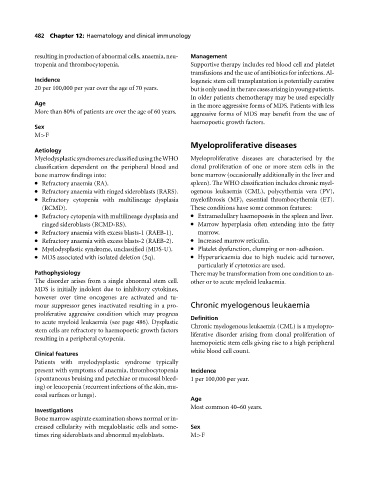Page 486 - Medicine and Surgery
P. 486
P1: KOA
BLUK007-12 BLUK007-Kendall May 12, 2005 20:37 Char Count= 0
482 Chapter 12: Haematology and clinical immunology
resulting in production of abnormal cells, anaemia, neu- Management
tropenia and thrombocytopenia. Supportive therapy includes red blood cell and platelet
transfusions and the use of antibiotics for infections. Al-
Incidence logeneic stem cell transplantation is potentially curative
20 per 100,000 per year over the age of 70 years. butisonlyusedintherarecasesarisinginyoungpatients.
In older patients chemotherapy may be used especially
Age in the more aggressive forms of MDS. Patients with less
More than 80% of patients are over the age of 60 years. aggressive forms of MDS may benefit from the use of
haemopoetic growth factors.
Sex
M>F
Myeloproliferative diseases
Aetiology
MyelodysplasticsyndromesareclassifiedusingtheWHO Myeloproliferative diseases are characterised by the
classification dependent on the peripheral blood and clonal proliferation of one or more stem cells in the
bone marrow findings into: bone marrow (occasionally additionally in the liver and
Refractory anaemia (RA). spleen). The WHO classification includes chronic myel-
Refractory anaemia with ringed sideroblasts (RARS). ogenous leukaemia (CML), polycythemia vera (PV),
Refractory cytopenia with multilineage dysplasia myelofibrosis (MF), essential thrombocythemia (ET).
(RCMD). These conditions have some common features:
Refractory cytopenia with multilineage dysplasia and
Extramedullary haemopoesis in the spleen and liver.
ringed sideroblasts (RCMD-RS). Marrow hyperplasia often extending into the fatty
Refractory anaemia with excess blasts-1 (RAEB-1).
marrow.
Refractory anaemia with excess blasts-2 (RAEB-2).
Increased marrow reticulin.
Myelodysplastic syndrome, unclassified (MDS-U).
Platelet dysfunction, clumping or non-adhesion.
MDS associated with isolated deletion (5q).
Hyperuricaemia due to high nucleic acid turnover,
particularly if cytotoxics are used.
Pathophysiology There may be transformation from one condition to an-
The disorder arises from a single abnormal stem cell. other or to acute myeloid leukaemia.
MDS is initially indolent due to inhibitory cytokines,
however over time oncogenes are activated and tu-
mour suppressor genes inactivated resulting in a pro- Chronic myelogenous leukaemia
proliferative aggressive condition which may progress
Definition
to acute myeloid leukaemia (see page 486). Dysplastic
Chronic myelogenous leukaemia (CML) is a myelopro-
stem cells are refractory to haemopoetic growth factors
liferative disorder arising from clonal proliferation of
resulting in a peripheral cytopenia.
haemopoietic stem cells giving rise to a high peripheral
white blood cell count.
Clinical features
Patients with myelodysplastic syndrome typically
present with symptoms of anaemia, thrombocytopenia Incidence
(spontaneous bruising and petechiae or mucosal bleed- 1per 100,000 per year.
ing) or leucopenia (recurrent infections of the skin, mu-
cosal surfaces or lungs).
Age
Most common 40–60 years.
Investigations
Bone marrow aspirate examination shows normal or in-
creased cellularity with megaloblastic cells and some- Sex
times ring sideroblasts and abnormal myeloblasts. M>F

